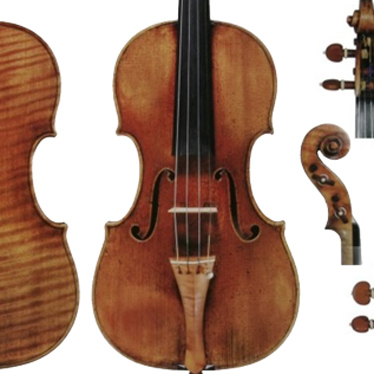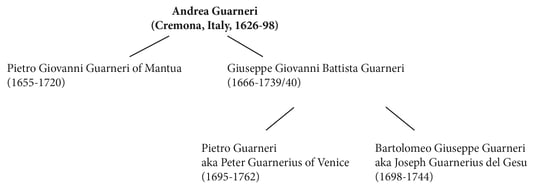11 Facts You Should Know about the Guarneri Family

For all the attention given virtuoso musicians, where would any of them be without an extraordinary instrument?
If you've been a violin student for any length of time, "Guarneri" is a name you've heard. Now is the time to learn a bit more about this famous family of luthiers.

- There were five Guarneris' who crafted string instruments. Patriarch Andrea Guarneri (1626 – 1698) represents a collision of all three great Italian luthier families. Andrea worked as an apprentice to Antonio Stradivari in the Amati workshop.
- Two of Andrea's sons and two of his grandsons also became luthiers. The most renowned of whom is his grandson Bartolomeo Giuseppe Guarneri (1698-1744), also known as Joseph Guarnerius del Gesù.
- The Guarneri family, like the Amati and Stradivari, was based in Cremona. They were the only of three families to branch out to other cities. Andrea's son Pietro left Cremona for Mantua. His grandson, Pietro, settled in Venice. It's believed that the Pietros preferred to establish themselves in cities with less crowded violin markets.
- There is no accurate record of the total numbers of violins, violas, and cellos created by the Guarneri family. Violins were their primary output, estimated that each produced a least around 250 violins, except perhaps Pietro da Mantua. There are roughly 120 Guarnerius del Gesù violins still in existence. It's believed there are six to seven remaining Guarneri violas. The Bisiach, Witten, believed to be the best-preserved Guarneri viola, has its home in the National Music Museum (Vermillion, South Dakota).
- While the other Guarneri, talented luthiers that they were, worked in the Amati or Stradivari style, Giuseppe broke with their traditions. His relatively short time as a luthier (around 24 years) was marked by experimentation in the design and construction of his violins. In his early years, Giuseppe worked very quickly, taking a trial and error approach with less thought to the precision of construction or varnish. He continued his experimentation for his entire career, such as fiddling with the length and of c-bouts and f-holes. However, the violins from his late period are the most prized, as he gave their construction and finish more attention than his earlier instruments.
- Pietro da Mantua produced the fewest instruments, most likely because he was also an accomplished, professional musician. Being a professional musician made him unique among luthiers. It's believed that only 50 violins made by him exist and perhaps one cello, that was previously attributed to his father.
- The Guarneris' was considered a lesser house of luthiers during their lifetime. While noble houses bought Stradivari and Amati violins, the humbler, working violinist preferred the Guarneri. Ironically, it may be precisely because the Guarneri instruments were affordable that the family's reputation would find the spotlight in the future.
- The family became more well known a hundred years after their heyday when Paganini began playing his famous Il Cannone de Gesù violin. Paganini acquired the Guarneri because he lost is Amati violin to pay off a gambling debt. The Guarneri was lent to him by an amateur violinist. Il Cannone was donated to Genoa in 1851. Barely played for decades, it was loaned to famous violinists in the early 20th century. Now, it's played at a concert once a year by the winner of the Paganini competition. American violinist Regina Carter was invited to perform with Il Cannone in 2001.
- As the Guarneri name became more well known in the 18th century, the common assumption at the time was that Joseph Guarnerius del Gesù was not a member of the Guarneri family. Later historians took a detailed look at contemporaneous violin labels and legal documents. They found irrefutable proof of del Gesù's place as grandson to Andrea and son to Giuseppe.
- While "Stradivarius" has popular name recognition, the instruments of Guarneri del Gesù get top dollar. Guarneri del Gesù violins take three spots on the "Five Most Expensive Violins Ever Sold" list. In addition, Guarneri del Gesù's violins, including his most valuable, continue to be used in public performances.
Josh Bell playing the "Vieuxtemps" Guarneri
- Two of Guarneri del Gesù's famous violins are considered twins, as they are believed to have been constructed from the same piece of wood. The Baron Vittaand Kreisler violins display "seemingly identical wood-grain patterns," which would be impossible if they weren't from the same source. The Kreisler was donated to the Library of Congress in 1952. The Baron Vitta was given to the Library in 2007, specifically to reunite the twin violins.
David Garret plays Gesù's "Stauffer" at Museo del Violino in Cremona
Here's a trivia bonus worth some exploration: The Guarneri Quartet, the famous American string quartet credited with being key contributors to the growth of chamber music in the United States, didn't perform on Guarneri instruments. The one exception was the use, for a time, of a cello crafted by Andrea by quartet member David Soyer.
The Guarneri Quartet, founded in 1964, disbanded in 2009. You can learn more about them in a highly entertaining documentary, High Fidelity.


